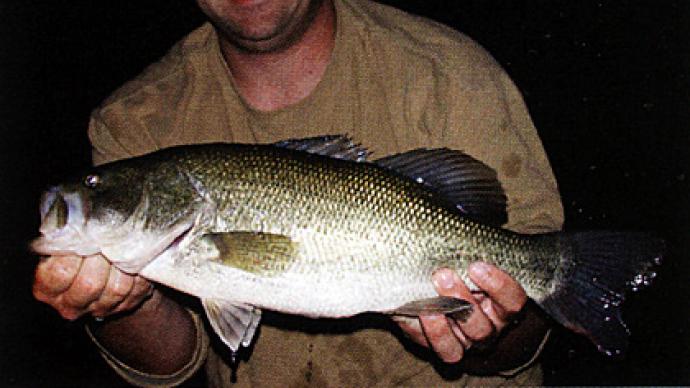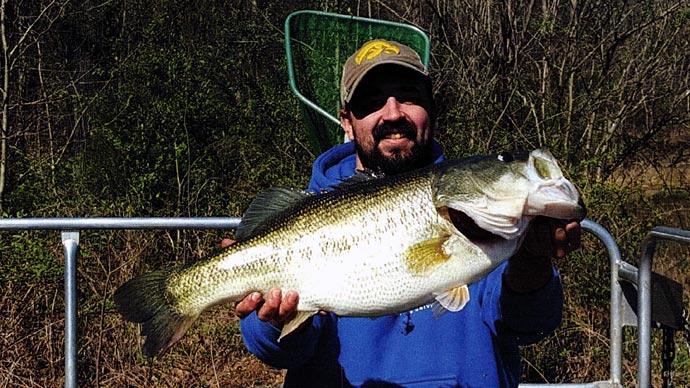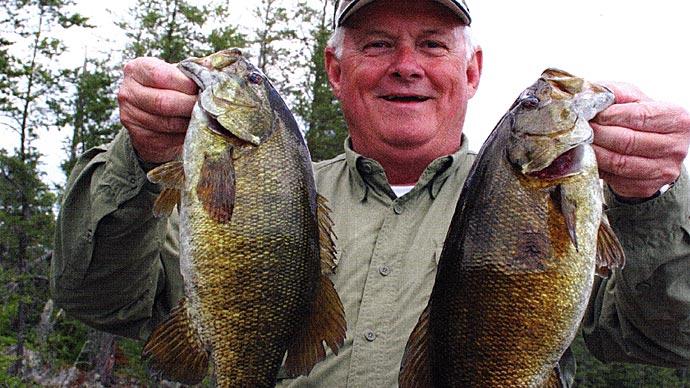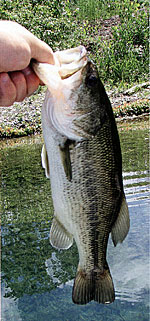
Every time the phone rings, a potential opportunity arises. That was the case when mine rang last year and a mild mannered, well spoken man with a Texas accent was on the other end. "Mark, this is Jack Daugherty from Fort Worth, Texas and I just bought a piece of property in upstate New York." He continued, "I just read your article on smallmouth bass in Pond Boss and I was wondering if you could help me out with some ponds." "Sure," I said and we immediately started talking ponds and fish. Jack and I met at the Pond Boss conference in March, 2007 and cemented plans to work together in upstate New York. I was reminded of an article Dave Willis wrote last year about how you meet the nicest people in the Pond Boss family.
Dave was right. Jack is one of those great Jack's project in New York is noteworthy... and darn interesting. He has found some property with old, open gravel mines that have naturally filled with water ... a lot of water. He has visions of making these two large, deep lakes into fishing preserves. I asked Jack "What do you want to do with them?" His answer was thoughtful. "Mark, I want to do what I can't do in Texas." He said "Let me tell you something, I can head out on the lake near my house and catch largemouth bass all day in the heat. I don't care if these New York ponds have a single largemouth bass in them." Hmm... this was a new one on me. He continued, "I want you to get out there and let me know what I have in those lakes and what we can do there." I thought to myself "OK, now we have a goal .... the opposite of Texas."
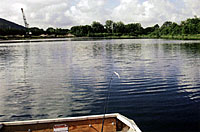
Armed with a depth finder, water meter, a HACH fish farmer test kit, a water bottle and a fishing rod (which is the most important piece of gear) I ventured out to Jack's new property.
I had seen gravel mine lakes before, but these were different. The water was a brilliant aquamarine color. I walked around the ponds (sorry they are actually lakes) for a few minutes, observing and looking. This place is impressive. Two ponds, er lakes, sat side by side with a north-south fetch. The easternmost lake covers about 20 acres and the western lake must be near 30 acres.
Both are crystal clear and deep.
The first thing we needed was a check-up on water quality. I hauled the S.S. Minnow (my 10 foot jon boat) out of the back of the pick-up and piled all the gear in. While launching and splashing the boat in the water I spooked a 20" largemouth bass from weeds near shore, leaving a huge swirl in its wake.

Water was so clear you could see the bass leave and head downward to the bottom, twenty feet below the boat. The clarity was amazing.
I immediately said to myself "Great... clear water equals low productivity." Taking the depth finder out of my pack, I started to check depths. This lake was a bathtub. Depths from north to south across the lake went like this: 16', 21' 24', 24', 29', 31', 28', 30', 32', 29', 32', 31', 31', 33', and 31'. The last reading 31' was less than 50' from the south shore!
Can you say "Steep?"
Then I broke out the meter and took a temperature profile. It was perfectly stratified, with a layer of 70F water at the top, then 10 feet of 60F water from 10-20', and a layer of 50F water from 20-30'. Nice! If he wanted, Jack could have a two storied fishery... warm and cool fish on top and trout on the bottom. Fifty degrees at the bottom! Brrr! Great for trout though! Next, was a check of the dissolved oxygen ... it was good all the way to the bottom, which meant that the entire water column had a dissolved oxygen concentration greater than 5 ppm. Deep, clear water has much greater potential to have and hold oxygen at deeper levels than lakes with high fertility levels.
The pH of both lakes was good, ranging between 7 and 8. Alkalinity, the ability for water to buffer an acid, was a little low at 35 ppm. But, 35 ppm is still above the industry minimum of 17 ppm. This lower alkalinity reading potentially means the pH of the lakes may change during the course of the day or through the year.
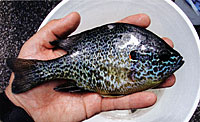
Hardness was good at 150-200 mg/L. Hardness is the concentration of calcium and magnesium in the water. Conductivity of the lakes was also good at 200-250 microsemens per centimeter (don't ask ... it's one way conductivity is measured). Hardness and conductivity are crude measures of productivity. The water chemistry was telling me that this lake should not be as blue and clear as it was. It has about the same chemistry as my pond ... and mine is a whole lot greener ... from planktonic algae.
I looked around the shore and found the partial answer to the mystery. Zebra mussels. These nasty little exotics had found their way into the lakes by a flood from a local stream. Each mussel (I saw thousands) can filter almost a liter of water a day and can keep a lake clearer than its water chemistry indicates.
Next the "reel" survey was conducted. I put away the water quality gear and picked up the fishin', `er sampling, stick. I flipped a white jig over the side of the boat and watched it go down, down, down all the way to the bottom in 25' of water!
I was on the water at a bad time for exploratory fishing, `er sampling. It was two in the afternoon and the sun shone high in a cloudless sky. I changed to a black jig and moved into deeper water while casting toward shore. I could peek over the side of the boat and identify fish as they cruised the shore. Largemouth bass (big ones too!), pumpkinseed, yellow perch, either bullhead or channel cats, carp, and an occasional chain pickerel sailed by as I spooked them from sparse cover. These fish could see me coming from a mile away.
I moved to deeper water to do a little jigging. I tossed a black hair jig over the side and let it fall to the bottom. I gave it one bounce and it stopped. Instinctively, I set the hook. Something monstrous pulled back. The drag squealed as the fish peeled line off the reel. The S.S. Minnow nosed down the lake against the wind ... the fish was pulling the boat. My reel continued singing.
I looked over the side of the boat and about 20' down I could see a silver flash that looked about four feet long in the magnified depths.
Yikes! "What the heck have I got?!!" I hollered out loud. I hoped my line (6 pound test!) held out long enough to find out.
Ten minutes and several hard runs later an exhausted 40 inch northern pike surfaced with my tiny black hair jig hanging from lip skin in the corner of its mouth. A few pictures were snapped as it swam by but as I tried to pick it up for a better picture, the jig popped out. With a splash of its mighty tail, it soaked me with spray, and was gone. Poof! Just like that. Gone. I sat in my tiny boat, dumbfounded, awestruck, mouth gaping, soaking in the moment as well as my clothes. Wow!
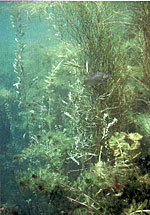
I quickly grabbed the camera to see if the pictures came out. They did. Sometimes people don't believe my stories unless I have a picture and even then I am sometimes called into question. Two pictures came out (see, I am not telling a fish story, one photo is in these pages) but they do not do that huge fish justice. It was a gorgeous monster... and it still swims. Over the course of the next few hours I caught a few bass, pumpkinseed, rockbass and saw numerous large bass over 5 pounds. What a place.
I called Jack and told him my story. No one could have been more delighted. Northern pike ... cool. Definitely different. So what is Jack going to manage these unique lakes for? The small lake will be managed for smallmouth bass and walleye. The larger 30 acre lake will be managed as a cold water trout fishery. Yes, this is the lake with the giant northern pike. He is still in there. Will that northern pike and his kin eat a trout ever once in a while? Yep, they will. Am I going to worry about it? No. I just love big toothy predators. So does Jack. If a nice trout makes a good meal for such a big fish, congratulations to the pike. I don't want to name names, but I am reminded that a certain Pond Boss editor (Yes, Bob Lusk) once used hatchery trout as a food source for trophy largemouth bass in another upstate New York Lake ... but that is another story. Why not here?
In the mean time ... these two lakes are totally different than what you might find in Texas. Nice place Jack!
Mark Cornwell is a fisheries professor at SUNY-Cobleskill in Cohleskill, New York. His passion is raising walleye and the I.Q. of fisheries students in the Northeast.
Reprinted with permission from Pond Boss Magazine

